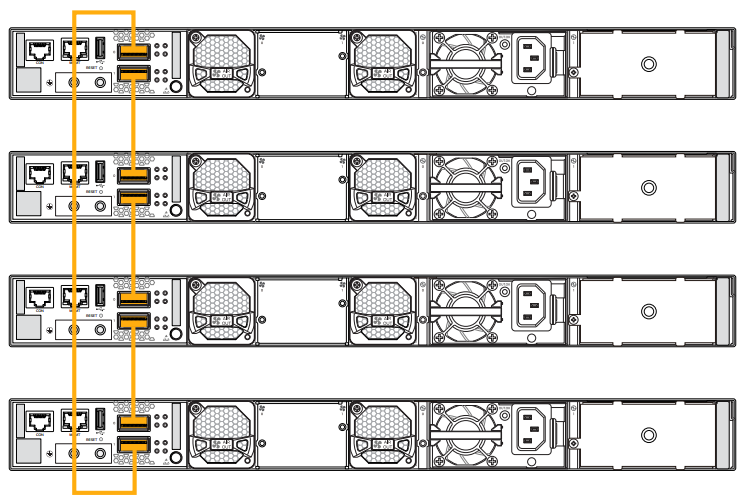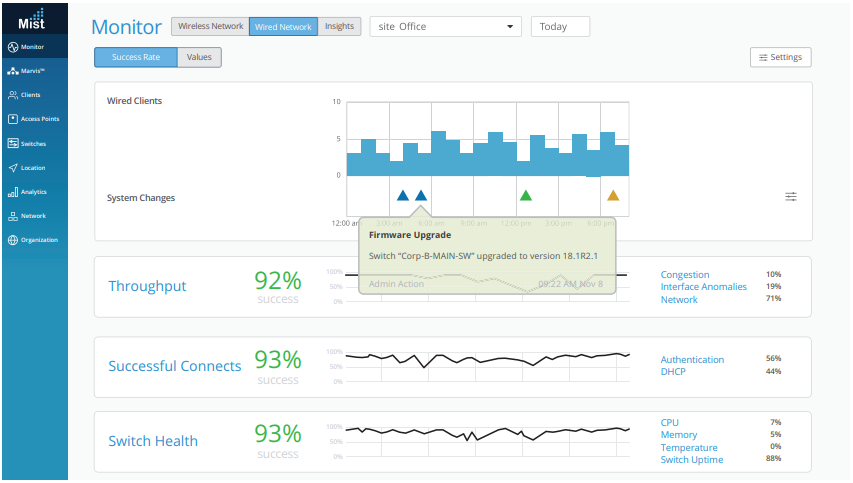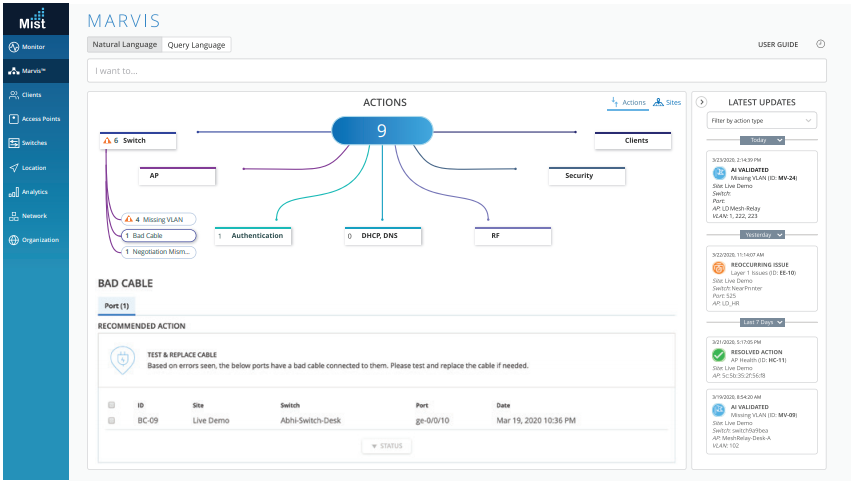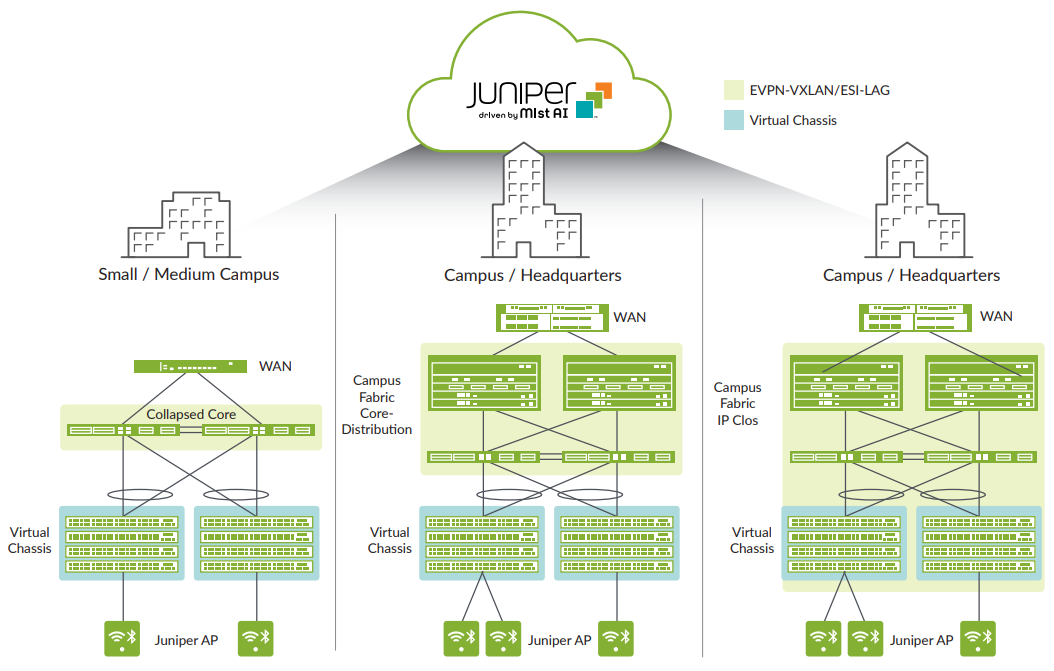Overview:
The EX4400 line of Ethernet access switches offers secure, cloud-ready access for enterprise campus, branch, and data center networks for the AI era and optimized for the cloud. The platforms boost network performance and visibility, meeting the security demands of today as well as for networks of the next decade.
As part of the underlying infrastructure for the Mist™ platform Wired Assurance, the EX4400 is purpose-built for, and managed by, the cloud. The switch leverages Mist AI to simplify operations and provide better visibility into the experience of connected devices, delivering a refreshing, user experience-first approach to access layer switching.
The Juniper Networks EX4400 line of Ethernet switches offers a secure, cloud-ready portfolio of access switches ideal for enterprise branch, campus, and data center networks. The EX4400 switches combine the simplicity of the cloud, the power of Mist AI™, and a robust hardware foundation with best-in-class security and performance to deliver a differentiated approach to access switching in the cloud, mobile, and IoT era. With the Mist™ platform™ Wired Assurance, you can effortlessly onboard, configure, and manage the EX4400 from the cloud. This simplifies operations, improves visibility, and optimizes experiences for connected devices and users.
Key features:
- Cloud-ready, driven by Mist AI with the Mist™ platform Wired Assurance and Marvis Virtual Network Assistant
- Ethernet VPN–Virtual Extensible LAN (EVPN-VXLAN) to the access layer
- End-to-end encryption using Media Access Control Security (MACsec) AES256
- IEEE 802.3bz Multigigabit
- IEEE 802.3bt Power over Ethernet (PoE++)
- WiFi 7-ready switches, delivering up to 3600W of PoE power per switch
- Standards-based microsegmentation using group-based policies (GBP)
- Flow-based telemetry to monitor traffic flows for anomaly detection
- Precision Timing Protocol–Transparent clock
- 10-member Virtual Chassis support
Offering a full suite of Layer 2 and Layer 3 capabilities, the EX4400 enables a variety of deployments, including campus, branch, and data center top‑of‑rack deployments. As requirements grow, Juniper’s Virtual Chassis technology allows up to 10 EX4400 switches to be seamlessly interconnected and managed as a single device, delivering a scalable, pay‑as‑you‑grow solution for expanding network environments. The EX4400 models deliver up to 3600W of PoE power, making them ideal for Wi‑Fi 7 deployments, smart buildings including lighting, IoT sensors, HVAC, and management systems or supporting other power‑hungry PoE endpoints.
The EX4400 line consists of SKUs:
- The EX4400‑48MXP, offering 12 x 100M/1/2.5/5/10GbE and 36 x 100M/1/2.5GbE PoE access ports, delivering up to 90 W per PoE port with an overall total 3600 W of PoE power budget (using two power supplies)
- The EX4400-48MP, offering 12 x 100M/1/2.5/5/10GbE and 36 x 100M/1/2.5GbE PoE access ports, delivering up to 90 W per PoE port with an overall total 2200 W of PoE power budget (using two power supplies)
- The EX4400-24MP, offering 24 x 100M/1/2.5/5/10GbE PoE access ports, delivering up to 90 W per port with an overall total 1776 W of PoE power budget (using two power supplies). A total PoE budget of 2160 W can be achieved with two optional 1600 W power supplies
- The EX4400-24T, offering 24 x 1GbE non-PoE access ports
- The EX4400-24P, offering 24 x 1GbE PoE access ports, delivering up to 90 W per port with an overall total 1806 W of PoE power budget (using two power supplies). A total PoE budget of 2160 W can be achieved with two optional 1600 W power supplies
- The EX4400‑48XP, offering 48 x 1GbE PoE access ports, delivering up to 90 W per port with an overall total 3600 W of PoE power budget (using two power supplies)
- The EX4400-48P, offering 48 x 1GbE PoE access ports, delivering up to 90 W per port with an overall total 2200 W of PoE power budget (using two power supplies)
- The EX4400-24X, offering 24 x 10GbE SFP+ fiber access/distribution ports
- The EX4400-48F, offering 12 x 10GbE SFP+ and 36 x 1GbE SFP fiber access ports
Each EX4400 model offers a choice of optional 4 x 1/10GbE SFP+, a 4 x 1/10/25GbE SFP28 and a 1 x 100GbE QSFP28 extension module. The EX4400 switches include two dedicated 100GbE ports to support virtual chassis connections that can be reconfigured to be used as Ethernet ports for uplink connectivity. The 100GbE ports can also accept 40GbE optics for virtual chassis connection or uplink connectivity. EX4400 switches also include high availability (HA) features such as redundant, hot‑swappable power supplies, and field‑replaceable fans to ensure maximum uptime. In addition, PoE‑enabled EX4400 switch models offer standards‑based 802.3af/at/bt (PoE/PoE+/PoE++) for delivering up to 90 watts on any access port. The EX4400 switches can be configured to deliver fast PoE capability that enables the switches to deliver PoE power to connected PoE devices within a few seconds of power being applied to the switches. In addition, the EX4400 switches support perpetual PoE that provides uninterrupted power to connected PoE powered devices (PDs), even when the switch is rebooting.
Architecture and Key Components:
Cloud Management with the Mist™ platform Wired Assurance Driven by Mist AI
EX4400 switches can be quickly and easily onboarded (Day 0), provisioned (Day 1), and managed (Day 2+) from the cloud with the Mist™ platform Wired Assurance, which brings AI-powered automation and insights that optimize experiences for endusers and connected devices. The EX4400 provides the rich Junos® operating system telemetry data for Mist AI, which helps achieve simpler operations, shorter mean time to repair (MTTR), and streamlined troubleshooting.
As a complementary service to the Mist™ platform Wired Assurance, Marvis Virtual Network Assistant—a key part of The SelfDriving Network™—makes the Mist AI engine interactive. A digital extension of the IT team, Marvis offers automatic fixes or recommended actions, allowing IT teams to streamline how they troubleshoot and manage their network operations.
EVPN-VXLAN Technology
Most traditional campus networks have used a single-vendor, chassis-based architecture that worked well for smaller, static campuses with few endpoints. However, this approach is too rigid to support the changing needs of modern campus networks. The EX4400 supports EVPN-VXLAN, extending an end-to-end fabric from campus core to distribution to the access layer.
An EVPN-VXLAN fabric is a simple, programmable, highly scalable architecture built on open standards. This technology can be applied in both data centers and campuses for architectural consistency. A campus EVPN-VXLAN architecture uses a Layer 3 IP-based underlay network and an EVPN-VXLAN overlay network. A flexible overlay network based on a VXLAN overlay with an EVPN control plane efficiently provides Layer 2 and/or Layer 3 connectivity throughout the network.
The main advantages of EVPN-VXLAN in campus networks are:
- Flexibility of consistent VLANs across the network: Endpoints can be placed anywhere in the network and remain connected to the same logical L2 network, enabling a virtual topology to be decoupled from the physical topology.
- Microsegmentation using group-based policy: Group-based policies (GBP) with EVPN-VXLAN-based architecture let you deploy a common set of policies and services across campuses with support for L2 and L3VPNs.
- Scalability: With an EVPN control plane, enterprises can scale out easily by adding more core, aggregation, and access layer devices as the business grows without having to redesign the network or perform a forklift upgrade. Using an L3 IP-based underlay coupled with an EVPN-VXLAN overlay, campus network operators can deploy much larger and more resilient networks than would otherwise be possible with traditional L2 Ethernet-based architectures.
Virtual Chassis Technology
Juniper’s Virtual Chassis technology allows multiple interconnected switches to operate as a single, logical unit, enabling users to manage all platforms as one virtual device.
Up to 10 EX4400 switches can be interconnected as a Virtual Chassis using two 100GbE ports. These ports are located on the front-panel for EX4400-24X and on the rear-panel for the remaining EX4400 switches. They accept 100G and 40G optics and are configured as Virtual Chassis ports by default (except for EX4400-24X).
As 100GbE uplinks, these ports can also be channelized as 4 x 10GbE/25GbE Ethernet uplink ports.
The EX4400 switches support HiGig as well as HiGig over Ethernet (HGoE) protocols for forming a virtual chassis. However, the EX4400-24X supports only HGoE protocol for virtual chassis formation. A virtual chassis consisting of EX4400 switches (except EX4400-24X) may use either the HiGig protocol (default) or the HGoE protocol. A virtual chassis consisting of only EX4400-24X switches or a mix of any EX4400 and EX4400-24X switches, must use HGoE protocol to form a virtual chassis.

Figure 1: EX4400 Virtual Chassis configuration interconnected via dedicated rear-panel 100GbE ports
Flow-Based Telemetry
Flow-based telemetry enables flow-level analytics, allowing network administrators to monitor thousands of traffic flows on the EX4400 without burdening the CPU. This improves network security by monitoring, baselining, and detecting flow anomalies. For example, if predefined flow thresholds are breached due to an attack, IP Flow Information Export (IPFIX) alerts can be sent to an external server so the attack can be quickly identified. Network administrators can also automate specific workflows, such as further examining the traffic or quarantining a port, to triage the issue.
Features and Benefits:
Simplified operations with the Mist™ platform Wired Assurance
The EX4400 is fully cloud onboarded, provisioned, and managed by the Mist™ platform Wired Assurance. The EX4400 is designed from the ground up to deliver the rich telemetry that enables AI for IT operations (AIOps) with simplified operations from Day 0 to Day 2 and beyond. the Mist™ platform Wired Assurance provides detailed switch insights for easier troubleshooting and improved time to resolution by offering the following features:
- Day 0 operations: Onboard switches seamlessly by claiming a greenfield switch or all purchased switches with a single activation code for true plug-and-play simplicity. You may also onboard brownfield switches with the adopt switch process.
- Day 1 operations: Implement a template-based configuration model for bulk rollouts of traditional and campus fabric deployments while retaining the flexibility and control required to apply custom site- or switch-specific attributes. Automate provisioning of ports via Dynamic Port Profiles.
- Day 2 operations: Leverage the AI in the Mist™ platform Wired Assurance to meet service‑level expectations such as throughput, successful connects, switch health, and switch bandwidth with key pre‑ and post‑connection metrics (see Figure 2). Add the self‑driving capabilities in Marvis Actions to detect needle in the haystack issues such as missing VLANs, DHCP failure scopes, wired authentication failures, bad cables, port negotiation mismatches, persistently failing clients, detection of L2 loops, misconfigured ports, and traffic loops (see Figure 3). Perform software upgrades easily through the Mist™ platform cloud. EX4400 switches also support secure packet capture (pcap) and export to an external collector (in the cloud) to aid in monitoring and troubleshooting poor network experience.

Figure 2: the Mist™ platform Wired Assurance service-level expectations screen

Figure 3: Marvis Actions for wired switches
The addition of Marvis lets you start building a self-driving network that simplifies network operations and streamlines troubleshooting via automatic fixes for EX Series switches or recommended actions for external systems.
EX4400 Deployments
The EX4400 switches can be deployed in branch and campus access/distribution layer networks or as top-of-rack switches in data center environments. 10GbE/25GbE/40GbE/100GbE uplinks support technologies such as EVPN multihoming etc.
EVPN-VXLAN for Campus Core, Distribution, and Access
Juniper offers complete flexibility in choosing any of the following validated EVPN-VXLAN campus fabrics that cater to networks of different sizes, scale, and segmentation requirements:
- EVPN multihoming (collapsed core or distribution): A collapsed core architecture combines the core and distribution layers into a single switch, turning the traditional three-tier hierarchal network into a two-tier network. EVPN multihoming on a collapsed core eliminates the need for Spanning Tree Protocol (STP) across campus networks by providing link aggregation capabilities from the access layer to the core layer. This topology is best suited for small to medium distributed enterprise networks and allows for consistent VLANs across the network. This topology uses ESI (Ethernet Segment Identifier) LAG (Link Aggregation) and is a standards-based protocol.
- Campus Fabric Core distribution: When EVPN VXLAN is configured across core and distribution layers, it becomes a campus Fabric Core Distribution architecture that can be configured in two modes: centrally or edge routed bridging overlay. This architecture provides an opportunity for an administrator to move toward campus-fabric IP Clos without a forklift upgrade of all access switches in the existing network while bringing in the advantages of moving to a campus fabric and providing an easy way to scale out the network.
- Campus fabric IP Clos: When EVPN VXLAN is configured on all layers, including access, it is called the campus fabric IP Clos architecture. This model is also referred to as “end‑to‑end,” given that VXLAN tunnels are terminated at the access layer. The availability of VXLAN at access layer provides the opportunity to bring policy enforcement and microsegmentation to the access layer (closest to the source) using standards‑based Group Based Policy (GBP) to segment traffic even within a VLAN. GBP tags are assigned dynamically to clients as part of Radius transaction by the Mist™ platform Cloud NAC. This topology works for small, medium, and large campus architectures that need macro and microsegmentation.
In all these EVPN-VXLAN deployment modes, EX4400 switches can be used in standalone or Virtual Chassis configurations. All three topologies are standards-based and interoperable with third-party vendors.

Figure 4: Campus fabrics showing Virtual Chassis and EVPN-VXLAN-based architectures
Managing AI-driven Campus Fabric with the Juniper
Mist Cloud
the Mist™ platform Wired Assurance brings cloud management and Mist AI to campus fabrics. It sets a new standard that moves away from traditional network management toward AI-Native operations, while delivering better experiences to connected devices. The Mist™ platform Cloud streamlines deployment and management of campus fabric architectures by allowing:
- Automated deployment and zero touch deployment (ZTD)
- Anomaly detection
- Root cause analysis
Chassis class availability
The EX4400 switches deliver high availability through redundant power supplies and fans, graceful Routing Engine switchover (GRES), and nonstop bridging and routing when deployed in a Virtual Chassis configuration.
In a Virtual Chassis configuration, each EX4400 switch is capable of functioning as a Routing Engine (RE). When two or more EX4400 switches are interconnected, a single control plane is shared among all Virtual Chassis member switches. Junos OS automatically initiates an election process to assign a master (active) and backup (hot-standby) RE. An integrated L2 and L3 GRES feature maintains uninterrupted access to applications, services, and IP communications in the unlikely event of a primary RE failure.
When more than two switches are interconnected in a Virtual Chassis configuration, the remaining switch elements act as line cards and are available to assume the backup RE position should the designated master fail. Master, backup, and line card priority status can be assigned to dictate the order of ascension. This N+1 RE redundancy, coupled with the GRES, nonstop active routing (NSR), and nonstop bridging (NSB) capabilities of Junos OS, assures a smooth transfer of control plane functions following unexpected failures.
The EX4400 implements the same slot/module/port numbering schema as other Juniper Networks chassis-based products when numbering Virtual Chassis ports, providing true chassis-like operations. By using a consistent operating system and a single configuration file, all switches in a Virtual Chassis configuration are treated as a single device, simplifying overall system maintenance and management.
Individually, the EX4400 offers a number of HA features that are typically associated with modular chassis-based switches. When combined with the field-proven Junos OS and L2/L3 failover capabilities, these features provide the EX4400 with true carrier-class reliability.
- Redundant power supplies: The EX4400 line of Ethernet switches supports redundant, load-sharing, hot-swappable, and field-replaceable power supplies to maintain uninterrupted operations. Thanks to its compact footprint, the EX4400 requires significantly less power than chassis-based switches delivering equivalent port densities.
- Hot-swappable fans: The EX4400 includes hot-swappable fans, providing sufficient cooling (for a short duration), even if one of the fans were to fail.
- Nonstop bridging and nonstop active routing: NSB and NSR on the EX4400 ensure that control plane protocols, states, and tables are synchronized between primary and standby REs to prevent protocol flaps or convergence issues following a Routing Engine failover.
- Redundant trunk group (RTG): To avoid the complexities of Spanning Tree Protocol (STP) without sacrificing network resiliency, the EX4400 employs redundant trunk groups to provide the necessary port redundancy and simplify switch configuration.
- Cross-member link aggregation: Cross-member link aggregation allows redundant link aggregation connections between devices in a single Virtual Chassis configuration, providing an additional level of reliability and availability.
- IPv4 and IPv6 routing support: IPv4 and IPv6 Layer 3 routing (OSPF and BGP) is available with an Enhanced license, enabling highly-resilient networks.
MACsec AES256
The EX4400 switches support IEEE 802.1ae MACsec with AES-256-bit encryption to increase security of point-to-point traffic communications. MACsec provides encrypted communication at the link layer that is capable of identifying and preventing threats from denial of service (DoS) and other intrusion attacks, as well as man-in-the-middle, masquerading, passive wiretapping, and playback attacks launched from behind the firewall. When MACsec is deployed on all ports, the traffic is encrypted on the wire, but the traffic inside the switch is not. This allows the switch to apply network policies such as quality of service (QoS) or deep packet inspection (DPI) to each packet without compromising the security of packets on the wire. On the EX4400 switches, the MACsec AES-256 encryption capability is supported on all user-facing interfaces and the 25GbE and 100GbE extension modules. EX4400-24X supports MACsec AES256 on the native front-panel 100GbE ports as well.
PoE/PoE+/Poe++ power, perpetual and fast PoE
The EX4400 delivers PoE for supporting connected devices such as phones, surveillance cameras, IoT devices, and 802.11AX/Wi‑Fi 6/Wi‑Fi 7 access points, offering a PoE power budget of up to 360036 W and supporting up to 90 W per port based on the IEEE 802.3bt PoE standard. With their higherhigher PoE budget, EX4400 switches can can support building lighting and IOT sensors in new buildings, helping to simplify the power cabling infrastructure.
The EX4400 switches support perpetual PoE, which provides uninterrupted power to connected PoE powered devices (PDs) even when the switch is rebooting.
The EX4400 switches also support a fast PoE capability that delivers PoE power to connected endpoints during a switch reboot, even before the switch is fully operational. This is especially beneficial in situations where the endpoint only needs the power and is not necessarily dependent on network connectivity.
Junos Telemetry Interface
The EX4400 supports Junos telemetry interface (JTI), a modern telemetry streaming feature designed for switch health and performance monitoring. Sensor data can be streamed at configurable periodic intervals to a management system, enabling network administrators to monitor individual link and node utilization as well as troubleshoot issues such as network congestion in real time. JTI delivers the following features:
- Performance management by provisioning sensors to collect and stream data and analyze application and workload flow paths through the network
- Capacity planning and optimization by proactively detecting hotspots and monitoring latency and microbursts
- Troubleshooting and root cause analysis via high-frequency monitoring and correlation of overlay and underlay networks
Junos Operating System
The EX4400 switches run Junos OS, Juniper’s powerful and robust network operating system that powers all Juniper switches, routers, and firewalls. By utilizing a common operating system, Juniper delivers a consistent implementation and operation of control plane features across all products. To maintain that consistency, Junos OS adheres to a highly disciplined development process that uses a single source code and employs a highly available modular architecture that prevents isolated failures from bringing down an entire system.
These attributes are fundamental to the core value of the software, enabling all Junos OS-powered products to be updated simultaneously with the same software release. All features are fully regression tested, making each new release a true superset of the previous version. Customers can deploy the software with complete confidence that all existing capabilities are maintained and operate in the same way.
Flex Licensing
Juniper Flex licensing offers a common, simple, and flexible licensing model for EX Series access switches, enabling customers to purchase features based on their network and business needs.
Flex licensing is offered in Standard, Advanced, and Premium tiers. Standard tier features are available with the Junos OS image that ships with EX Series switches. Additional features can be unlocked with the purchase of a Flex Advanced or Flex Premium license.
The Flex and Premium licenses for the EX Series platforms are class-based, determined by the number of access ports on the switch. Class 1 (C1) switches have 12 ports, Class 2 (C2) switches have 24 ports, and Class 3 (C3) switches have 32 or 48 ports.
The EX4400 switches support both subscription and perpetual Flex licenses. Subscription licenses are offered for three- and five-year terms. In addition to Junos OS features, the Flex Advanced and Premium subscription licenses include the Mist™ platform Wired Assurance. Flex Advanced and Premium subscription licenses also allow portability across the same tier and class of switches, ensuring investment protection for the customer.









